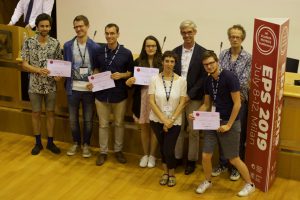Archie Bott (University of Oxford): Magnetic-field amplification in turbulent laser-plasmas
This work combines theoretical simulations and experimental
contributions in laser-generated-jet collision, in order to simulate in a
laboratory what happens in various astrophysical contexts. In only the first
year of his PhD, Archie Bott produced and published a complete theory of
magnetic-field reconstruction from protons radiographic images and a full set
of numerical codes needed to apply it. This “preparatory” work was used to
significantly enrich this diagnostic tool that provided new information from
experiments that he led on the most high-energy lasers in the word.
These original
studies and impressive work focused on time-resolved turbulent dynamo process.
At the end of his PhD, Archie Bott returned to more theoretical and fundamental
work, giving rise to another innovative publication of great depth in physics,
which is essentially a comprehensive treatise on plasma instabilities at high beta.
Bart Ripperda (KU Leuven University): On magnetic reconnection and particle acceleration in relativistic plasmas
This is a theoretical and simulation work that concerns the astrophysics, and more precisely the environment of black holes and neutron stars. In his PhD work, Bart Ripperda combines very strong knowledge and understanding of plasma physics and general relativity, which allows him to tackle problems that are well beyond the scope of traditional plasma physics and astrophysics. He built a variety of word-class numerical tools for plasma physics in strong gravitational fields, including numerical schemes for general relativistic resistive magneto-hydrodynamics, and a set of algorithms for pushing charged particles in electromagnetic fields around black holes. This remarkable work on particle dynamics in full general relativity is of highest quality, and has already received broad recognition in the international plasma astrophysics community. It directly benefits the Event Horizon Telescope collaboration for which he has been actively working for a year.
Kevin Verhaegh (University of York): Spectroscopic investigations of detachment on TCV: Investigating the role of atomic physics on the ion current rollover and the dynamics of detachment in TCV
This thesis presents new results on the physics of detachment in a tokamak divertor, a complex topic because it involves not only plasma physics but also atomic phenomena. This is extensively discussed in Kevin Verhaegh’s thesis, showing clearly that he understands very well this physics. Kevin Verhaegh developed excellent divertor measurements and a novel method to analyse the data taking into account both the recombination and excitation contributions to the Balmer lines. He shows convincingly that the ion flux is not only due to recombination, as assumed during the last two decades, but that, in addition, the ionisation of the neutrals is an important contribution. Furthermore, he demonstrates that the latter is limited by a loss of power into the divertor recycling region when density increases, contributing significantly to the saturation. He validated these important results with modelling using the edge and divertor code SOLPS-ITER, showing that the modelling results match the experimental observations much better than in the past. This new view contributes significantly to fusion research as divertor detachment will be required in future devices to reduce the power load. With this new knowledge modelling and extrapolation of divertor detachment are more reliable.
Rogério Jorge (EPFL & University of Lisbon): A moment-based model for plasma dynamics of arbitrary collisionality
This thesis tackles a long-standing problem,
namely, how to develop a set of equations that can uniformly describe plasma
behaviour in situations where the collisionality ranges from essentially
collision-less to highly collisional, a situation that pertains in the edge
region of a tokamak in particular. This region is crucial to a tokamak’s
performance and the viability of fusion as an energy source, controlling
overall confinement and exhaust; an ability to model the region is essential
for the development of fusion power. This thesis develops a set of fluid-like
moment equations suitable for this purpose. The derivation is based on a
Sonine-Laguerre expansion of the drift-kinetic plasma equations and treats the
full non-linear Coulomb collision operator, an analytic tour-de- force. The
model is appropriate for describing the scrape-off-region, which contains open
magnetic field lines and lies between the confined plasma region and the
containment vessel; furthermore, it can describe the large fluctuations that
are present there. A similar procedure
is also applied in the thesis to the full-F gyro-kinetic model, which is
suitable for modelling the adjacent confinement region of a tokamak. In
addition, efficient numerical algorithms for computing solutions to these
equations are formulated. Finally, the methodology is applied in practice to
study the impact of collisions on plasma oscillations and drift waves, using
different common simplified collision models; the results show surprising
sensitivities. The model is now ready
for application to the tokamak edge problem. This work, performed independently
and with considerable initiative, constitutes a seminal contribution to
magnetic confinement fusion, and plasma theory in general, demonstrating
novelty and originality and exhibits both analytic and numerical skills.


